The 'Mapping Data: Performing Landscape' seminar was successful in bringing together diverse approaches to Geographical Information Systems (see last post for the outline). As map-makers we have a responsibility to consider our work with care and rigour. If we agree that maps represent the values and cultures that create them, then we are laying down paths of data to be excavated in the future, not just to understand the data, but our assumptions and attitudes to it. Using digital geographic systems creates varying senses of scale and representation, not just in terms of located-ness, but also in terms of seeing the world as a virtual space. Questions about what we include, what we leave out, and how we can be transparent all need to be discussed from multiple perspectives. To quote John Pickles "Where technology is not seem as a social relation, it is fetishised and aestheticised, the contingent nature of technical outcomes is over-looked, and the struggles over the choice and application of any particular technology are ignored."(Pickles, 1995,pX).
The presentations were streamed online, and the archive can soon be viewed at http://stream.humlab.umu.se/. Unfortunately we had some sound problems with Jen Southern's streaming - but will hope to add subtitles in the New Year... Here's some information about each of the speakers, their presentations and my comments on the group discussion:
Jen Southern is an artist and PhD student in Sociology at Lancaster University, where she is affiliated to the Centre for Mobilities Research (CeMoRe) and mobilities lab. Her art practice is collaborative, process based and participatory, working with audiences to explore movement and sense of place through mobile technologies and locative media. She works across the disciplines of participatory art, sociology and mobile application design, and has contributed to international projects and workshops funded by NESTA, BBC, Arts Council England and Sagasnet. Jen’s research is currently exploring how the use of GPS changes perceptions of sense of place, particularly in relation to embodied practices of navigation and the GPS as a device for seeing from above. Her research takes place through socially engaged art practice and speculative mobile application design.
Per Sandström works at the Remote Sensing section in the Department of Forest Resource Management at SLU, Umeå. He is a wildlife biologist currently working with reindeer herding communities developing reindeer husbandry plans. The development of these plans combines the collection of traditional ecological knowledge of the Sámi reindeer herders with modern techniques of GIS and GPS collars on reindeer. In his presentation he illustrated how the collected spatial information can be used to communicate the land use needs in reindeer husbandry with other land users in an attempt to reduce conflicts.
Fredrik Palm is a cultural information technology expert at HUMlab, working with methodology development in the digital humanities. A particular focus has been visualization and especially digital cartography and dynamic maps, 3D-archeology, time-spatial representation/ exploration. Fredrik also has experience in creating, planning and managing a European Digital Library project under IST-FP6. Fredrik’s presentation ‘Abstracting Query Building for Multi-entity Faceted Browsing’ gave an overview of the QVIZ-project to support faceted browsing, focusing on the handling of larger, more complex relational database structures, discrete and continuous data, hierarchies, temporal and spatial data. Faceted browsing allows the creation of unpredictable arrangements of search criteria by the user. Such dynamics require a generic and abstracted mechanism in order to be able to adapt to multidimensional exploration and user requirements. Faceted browsers function through the progressive narrowing of choices in selected dimensions. The system is fully functional and is now being used in several digital humanities and multidisciplinary projects with different database schemata. http://www.springerlink.com/content/0285j5422t0x17k4/
Fredrik is planning to make a PHD-study based on the experience from HUMlab among researchers working with different digital infrastructures and forms of digital representation of data in the knowledge process.
Paul Arthur is a Research Fellow at HUMlab, visiting Umeå from Curtin University, Western Australia, where he works in the School of Media, Culture and Creative Arts. He has published widely on the history of technology and media, digital culture and identity, and on travel and cartography since the seventeenth century. He is author of the forthcoming books Virtual Voyages: Travel to the Antipodes 1605-1837 and History and New Media (London: Anthem Press). Paul brought the discussion back to the performance of social space through presenting a range of digital mapping projects in the USA and Australia which enable people to upload their own geographical and historical data to collectively built maps. He focused on his research into ‘Virtual Perth: Creating an online encyclopedia for the most isolated city in the world’.
Discussion
Jen Southern, Per Sandström and Paul Arthur clearly demonstrated the social processes and implications of their data gathered and performed through the development of social networks. Harder to comprehend for non-programmers, and non-specialists was the back-end computational databases which enable us to map data at vast scales and over time. Fredrik Palm's presentation revealed the distinctions between database building and the ability to analyse and present this specialist data to a wider audience.
After the presentations the speakers were joined by Philip Buckland, Marita Nilson and Brita Taljedal for fika and an informal discussion about their work. In some ways the juxtaposition of presentations highlighted the need for interdisciplinary discourse in the field, utilizing different critical perspectives to understand the different aspects of the technical, analytical and cultural issues we are exploring.
Per asked the question - How to communicate spacial information? which is a challenge for everyone. There is usually a gap between the collection and analysis of data, and it’s subsequent visualisation. This is partly due to funding and time restrictions, but also due to the distinct skills needed for each task. The problem of bringing in artists at the ‘end stage’ to decorate visualisation means that they are left out of the development stages of the conceptual framework for how and why the data is collected. As Jen Southern demonstrated through her practice, artists’ enquiry can playfully explore socio-political values and multi-layered approaches to geographic space which reveal new ways of thinking about methodology as well as analysis.
Everyone seemed to find the seminar helpful as a way to think through their individual research projects within a wider framework. And to a certain extent, the limitations of one project could be resolved by the potential of another. The seminar created a starting point for further discussions about the benefits and complexities of collaborative research, and we agreed to keep in touch and host further events exploring relationships between data and landscape, mapping and performance.
Further Reading
Doreen Massey (2005) For Space. Sage Publications.
John Pickles, Ed, (1995) Ground Truth: The Social Implications of Geographic Information Systems. The Guilford Press. New York.
Pertti J. Pelto. (1973/1987) The Snow Mobile Revolution: Technology and Social Change in the Arctic. Waveland Press.
Helen Liggett & David C. Perry, Eds. (1995). Spatial Practices. Sage Publications.
Monday, December 28, 2009
Monday, December 07, 2009
Mapping Data: Performing Landscape
Mapping Data: Performing Landscape
16 December 2009, 1 – 5pm
HUMlab, Umeå University, Sweden
Way back in the summertime Jen Southern (UK), Jen Hamilton and Chris St Amand (Canada) presented their Running Stitch artwork in the Open Source Embroidery exhibition at BildMuseet. Whilst the artists were in town we were all excited to meet Per Sandstrom at SLU who has been using GPS to track reindeer movement in Sweden. It seems that our relationship with landscape is being explored and challenged through GPS and GIS across the arts, humanities and sciences. Projects at HUMlab include QVIST led by Fredrik Palm, and Research Fellow Paul Arthur who has been working on the Virtual Perth project in Australia.
We all agreed that there must be points of synergy between researchers in different disciplines who are using this technology. Sharing our work may help to develop our understanding of our own practices, and to consider the cultural implications of our research. So at last we have organised a multidisciplinary seminar to take place in HUMlab on December 16th. 1-5pm. Everyone is welcome.
Speakers:
Paul Arthur, HUMlab Research Fellow. Virtual Perth, Electronic Cultural Atlas Initiative.
Jen Southern, Artist, University of Lancaster, UK.
Per Sandström, SLU, Forest Resource Management.
Fredrik Palm, QVIZ, HUMlab, Umeå University.
The seminar will explore questions such as: How does GPS affect our understanding of landscape? What are the cultural implications of GPS and GIS for the audience and for the mapmaker? How do we annotate and story tell? How can geographical data be explored, compared, analysed and animated over time?
This seminar is supported by HUMlab in partnership with BildMuseet at Umeå University.Contact: ele.carpenter@humlab.umu.se
16 December 2009, 1 – 5pm
HUMlab, Umeå University, Sweden
Way back in the summertime Jen Southern (UK), Jen Hamilton and Chris St Amand (Canada) presented their Running Stitch artwork in the Open Source Embroidery exhibition at BildMuseet. Whilst the artists were in town we were all excited to meet Per Sandstrom at SLU who has been using GPS to track reindeer movement in Sweden. It seems that our relationship with landscape is being explored and challenged through GPS and GIS across the arts, humanities and sciences. Projects at HUMlab include QVIST led by Fredrik Palm, and Research Fellow Paul Arthur who has been working on the Virtual Perth project in Australia.
We all agreed that there must be points of synergy between researchers in different disciplines who are using this technology. Sharing our work may help to develop our understanding of our own practices, and to consider the cultural implications of our research. So at last we have organised a multidisciplinary seminar to take place in HUMlab on December 16th. 1-5pm. Everyone is welcome.
Speakers:
Paul Arthur, HUMlab Research Fellow. Virtual Perth, Electronic Cultural Atlas Initiative.
Jen Southern, Artist, University of Lancaster, UK.
Per Sandström, SLU, Forest Resource Management.
Fredrik Palm, QVIZ, HUMlab, Umeå University.
The seminar will explore questions such as: How does GPS affect our understanding of landscape? What are the cultural implications of GPS and GIS for the audience and for the mapmaker? How do we annotate and story tell? How can geographical data be explored, compared, analysed and animated over time?
This seminar is supported by HUMlab in partnership with BildMuseet at Umeå University.Contact: ele.carpenter@humlab.umu.se
Friday, December 04, 2009
Public Craft
The next Open Source Embroidery project will be a book. Exactly what kind of book and how it will be published is still up for discussion. But it will be somewhere between a reader and source book of craft and code.
For newcomers to this blog - the Open Source Embroidery (OSE) project investigates how the open source software development model has been incorporated into the language of cultural participation. Tracing the history of craft and code from Ada Lovelace's notes on the Jaquard Loom and the Analytical Engine, to contemporary networked creativity using fabric and coded threads. ... However, there is still a gap between the 'theorists' and the 'practitioners' within the wider field. And I think there is a need for an accessible and rigorous publication bringing together key texts, new writing, and visual pages of art, craft and code.
A primary aim of the OSE project has been to make material the often invisible processes of digital networks and code. So it is important that the book exists as a coherent physical publication - as well as having some kind of open online publishing format. The urgent need for a critical enquiry might lead us to keep the texts as a permanent component, whilst enabling the visual pages to be selected.
I've just started to read Richard Sennett's The Craftsman where he describes Linux "a public craft"(Sennet, 2009, p24). His investigation into the relationship between technical and conceptual development in the process of making seems to make the OSE book a timely proposition. Unfortunately several of the books' reviews get bogged down in the argument as to whether Wikipedia is any good, and miss the point about the public ownership of craft skills, and the social networks which support both tradition and innovation. I can recommend Roger Scruton's review in The Times.
Watch this space for further info. We'll be sending out a call for contributions in early 2010.
For newcomers to this blog - the Open Source Embroidery (OSE) project investigates how the open source software development model has been incorporated into the language of cultural participation. Tracing the history of craft and code from Ada Lovelace's notes on the Jaquard Loom and the Analytical Engine, to contemporary networked creativity using fabric and coded threads. ... However, there is still a gap between the 'theorists' and the 'practitioners' within the wider field. And I think there is a need for an accessible and rigorous publication bringing together key texts, new writing, and visual pages of art, craft and code.
A primary aim of the OSE project has been to make material the often invisible processes of digital networks and code. So it is important that the book exists as a coherent physical publication - as well as having some kind of open online publishing format. The urgent need for a critical enquiry might lead us to keep the texts as a permanent component, whilst enabling the visual pages to be selected.
I've just started to read Richard Sennett's The Craftsman where he describes Linux "a public craft"(Sennet, 2009, p24). His investigation into the relationship between technical and conceptual development in the process of making seems to make the OSE book a timely proposition. Unfortunately several of the books' reviews get bogged down in the argument as to whether Wikipedia is any good, and miss the point about the public ownership of craft skills, and the social networks which support both tradition and innovation. I can recommend Roger Scruton's review in The Times.
Watch this space for further info. We'll be sending out a call for contributions in early 2010.
Thursday, October 29, 2009
OSE at MOCFA on YouTube
The Open Source Embroidery exhibition at the Museum of Craft and Folk Art opened in a buzz of excitement on October 1st. The gallery was packed with objects and people with a range of interests in art, craft and programming. Throughout the evening Studio Galli filmed Ele (me) introducing the HTML Patchwork, Running Stitch and Yarn Text. Travis Meinolf and Michele Pred also talked about their artworks in the exhibition.
Monday, October 26, 2009
Masking Tape History of Mondrian

I generally grumble about the integration of American culture into British culture, I like to think I can do without the global everything default. But there are some really truly great things about America which just haven't caught on in Europe. One of these things is coloured masking tape (painters tape). Red for high-tac, blue for medium-tac, and green for low-tac. It's practical, beautiful, and great for colour coding objects and tools as well as decorating, wrapping art works and planning a geometric painting.
My second day in San Francisco saw me purchase 4 roles of tape to bring home with me from the Cole Fox Hardware store (see last post). My last day was spent soaking up artwork at SFMOMA. And there I saw a 'work in progress' painting by Mondrian employing the use of primary coloured tape to design his painting. In my basic A-level Arthistory we learned about Broadway Boogie Woogie, the impact of Jazz and the American city grid structure on his painting - but no-one mentioned coloured masking tape as an essential tool in planning and influencing Mondrian's colour... did they?
Please correct me if you have an expert knowledge of Mondrian and can provide an arthistorical link to the impact of coloured masking tape on his practice.
Slow Networking
Here is the story of my map of the social networks that brought me to the Micro Makers Fair at the May You Live In Interesting Times festival at Chapter in Cardiff this weekend, and the new people I met, and the people we know in common.
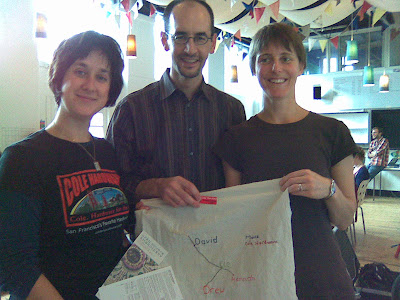
On the first day I wore my Cole Fox Hardware Store T-shirt for the first time. I bought the T-Shirt whilst I was installing the Open Source Embroidery exhibition at the Museum of Craft and Folk Art in San Francisco, where I made regular visits to the shop that sells everything, including red blue and green masking tape (see a future post on the missing arthistory of Mondrian’s love of American masking tape). The window display of the store is designed by an artist to exquisitely present hardware objects by colour. So imagine my surprise when 2 visitors to the Fair recognize my T-Shirt and pull out their house keys with a Cole Fox key tag – we are instantly connected in our love of the store, and they tell me their story of their move from San Francisco to Cardiff. Catherine stitches Mark’s name and 'Cole Fox Hardware' onto the map, whilst Mark entertains their little boy.

I was invited to take part in the Micro Maker Fair by Hannah, who I’ve known since the late 1990s when we both lived and worked in Newcastle. We’ve loosely kept in touch partly through art events, bumping into each other in Venice, and partly through our dear friend Julie. I knew Hannah would be super-busy with the opening of the newly refurbished Chapter Arts Centre and running the festival, so I stitched her name onto my network map. At the GwdDiHw (Goodie Who) bar I met Matthew and Tomascz who explained that they were living in Interesting Times in Cardiff. Matthew teaches computer gaming things at the University with Corrado whom I recognized from the opening of OSE at HTTP back in May 2007, Corrado knows Mark and Ruth from Furtherfield. They also know Hannah through Chapter. Then FutureEverything Drew arrived so I added them all to a sketch on the back of my print out of a google map of Cardiff. They all promised to come to the Maker Fair to stitch their names on the map. Drew came along and diligently stitched his name in bright orange. The others didn’t turn up, and I remember that real networks are formed by the people who show up.

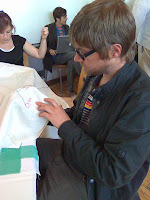 The Fair is a hectic mix of stalls in the Chapter Stwdio. I'm squeezed between Dorkbot Bristol and wonderful Piano Migrations.
The Fair is a hectic mix of stalls in the Chapter Stwdio. I'm squeezed between Dorkbot Bristol and wonderful Piano Migrations.
Later in the afternoon Alison from Bracket drops by the stall – Ah! She knows David Littler from the Sampler Culture Clash project in Brixton, they have similar music interests and often go to the same gigs. We spend an hour or so discussing our work. Saul drops by from The People Speak – he knows Hannah, Drew and me, so the connecting network lines will get interwoven when Saul is added. He has to write some code and doesn’t have time to stitch. I promise to add him on another time.
In the Chapter Café Bar I bump into my old friends Jo and Roy who I know through exhibitions, art film screenings and conferences, but also because my parents live near them in Southampton. We all attended our friend Debbie Fenwick’s wedding in Northumberland years back, and spent a tense hour driving around fantastic countryside looking for the country house, and arriving just in time for the ceremony. I love Jo because she talks about her job as a curator of Aspex Gallery in a very straightforward way. And of course Hannah and Jo know each other through work and location connections too.
When I meet up with Jo and Roy later in the day they are having coffee with Ellie Harrison, the data collector extraordinaire and Neil Mullholland, whom I’ve nearly met on many occasions, but not quite. I first met Ellie through LabCulture in Bridport, and organized an exhibition including her work at Peterborough Art Gallery sometime in 2003 I think. Ellie starts to stitch her name, but is called away by promises of a curry, so I giver her the whole map for her to sew in her own time and post it back to me…..
As Sophie stitches her name onto the Maker Fair map she quizzes me about why I think people have such a strong need to articulate their social networks, she thinks people are scarred of being invisible. I return to Baran’s notes on distributed networks – his vision in 1964 was a communication network which was indestructable. I think there’s an interesting correlation between Sophie’s survivalist stall of Wild Wood weapons for hunting and the need for a survivalist communication network. A point not missed in Heath Bunting’s work, and of course Sophie is selling Heath’s ‘Throwing Stones’. I decide to add Heath and Sophie to my network when I get it back from Ellie.
My other plan was to invite people to ‘speed-date their 6 degrees of separation’ and embroider their connections. But you just can’t ‘speed-stitch’, it’s a process of slowing down and careful precision. So whilst some people drew their 6 degrees of separation, there was too much going on for people to sit and sew their network. This is a project for hours of concentration.

On the first day I wore my Cole Fox Hardware Store T-shirt for the first time. I bought the T-Shirt whilst I was installing the Open Source Embroidery exhibition at the Museum of Craft and Folk Art in San Francisco, where I made regular visits to the shop that sells everything, including red blue and green masking tape (see a future post on the missing arthistory of Mondrian’s love of American masking tape). The window display of the store is designed by an artist to exquisitely present hardware objects by colour. So imagine my surprise when 2 visitors to the Fair recognize my T-Shirt and pull out their house keys with a Cole Fox key tag – we are instantly connected in our love of the store, and they tell me their story of their move from San Francisco to Cardiff. Catherine stitches Mark’s name and 'Cole Fox Hardware' onto the map, whilst Mark entertains their little boy.

I was invited to take part in the Micro Maker Fair by Hannah, who I’ve known since the late 1990s when we both lived and worked in Newcastle. We’ve loosely kept in touch partly through art events, bumping into each other in Venice, and partly through our dear friend Julie. I knew Hannah would be super-busy with the opening of the newly refurbished Chapter Arts Centre and running the festival, so I stitched her name onto my network map. At the GwdDiHw (Goodie Who) bar I met Matthew and Tomascz who explained that they were living in Interesting Times in Cardiff. Matthew teaches computer gaming things at the University with Corrado whom I recognized from the opening of OSE at HTTP back in May 2007, Corrado knows Mark and Ruth from Furtherfield. They also know Hannah through Chapter. Then FutureEverything Drew arrived so I added them all to a sketch on the back of my print out of a google map of Cardiff. They all promised to come to the Maker Fair to stitch their names on the map. Drew came along and diligently stitched his name in bright orange. The others didn’t turn up, and I remember that real networks are formed by the people who show up.

 The Fair is a hectic mix of stalls in the Chapter Stwdio. I'm squeezed between Dorkbot Bristol and wonderful Piano Migrations.
The Fair is a hectic mix of stalls in the Chapter Stwdio. I'm squeezed between Dorkbot Bristol and wonderful Piano Migrations.Later in the afternoon Alison from Bracket drops by the stall – Ah! She knows David Littler from the Sampler Culture Clash project in Brixton, they have similar music interests and often go to the same gigs. We spend an hour or so discussing our work. Saul drops by from The People Speak – he knows Hannah, Drew and me, so the connecting network lines will get interwoven when Saul is added. He has to write some code and doesn’t have time to stitch. I promise to add him on another time.
In the Chapter Café Bar I bump into my old friends Jo and Roy who I know through exhibitions, art film screenings and conferences, but also because my parents live near them in Southampton. We all attended our friend Debbie Fenwick’s wedding in Northumberland years back, and spent a tense hour driving around fantastic countryside looking for the country house, and arriving just in time for the ceremony. I love Jo because she talks about her job as a curator of Aspex Gallery in a very straightforward way. And of course Hannah and Jo know each other through work and location connections too.
When I meet up with Jo and Roy later in the day they are having coffee with Ellie Harrison, the data collector extraordinaire and Neil Mullholland, whom I’ve nearly met on many occasions, but not quite. I first met Ellie through LabCulture in Bridport, and organized an exhibition including her work at Peterborough Art Gallery sometime in 2003 I think. Ellie starts to stitch her name, but is called away by promises of a curry, so I giver her the whole map for her to sew in her own time and post it back to me…..
As Sophie stitches her name onto the Maker Fair map she quizzes me about why I think people have such a strong need to articulate their social networks, she thinks people are scarred of being invisible. I return to Baran’s notes on distributed networks – his vision in 1964 was a communication network which was indestructable. I think there’s an interesting correlation between Sophie’s survivalist stall of Wild Wood weapons for hunting and the need for a survivalist communication network. A point not missed in Heath Bunting’s work, and of course Sophie is selling Heath’s ‘Throwing Stones’. I decide to add Heath and Sophie to my network when I get it back from Ellie.
My other plan was to invite people to ‘speed-date their 6 degrees of separation’ and embroider their connections. But you just can’t ‘speed-stitch’, it’s a process of slowing down and careful precision. So whilst some people drew their 6 degrees of separation, there was too much going on for people to sit and sew their network. This is a project for hours of concentration.
Monday, September 28, 2009
Weaving the Web
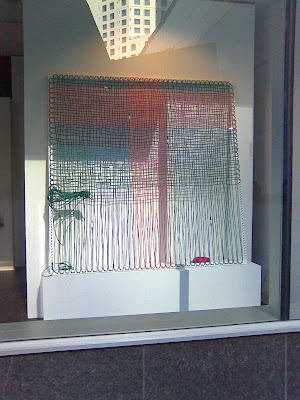
This week I'm at the Museum of Craft and Folk Art (MOCFA) in San Francisco installing the Open Source Embroidery exhibition. It's great to be in the heart of the radical history of computing, from Berkeley Unix to the WELL. Interestingly MOCFA began as an education programme that needed a museum, so the OSE project is warmly welcomed as an engaging and participatory exhibition which challenges the distinctions between amateur and professional practice. I've just finished an interview with Ceci Moss at Rhizome on this very topic - here is the Rhizome link.
Inspired by Paul Grimmer's Ethernet (Swatch), I've been working with Californian Action Weaver Travis Meinolf to create a large scale internet cable weaving for the MOCFA window. Travis imeadiately worked out that we needed red, green and blue cable on a 72 x 72 inch frame. After carefully protecting each screw on the frame with a nylon spacer, the weaving commenced. Couplers connect the lengths of 100 feet cable, which will be too long to support an unaided internet signal. But it wont stop us from trying... plan B is to use one single weft to carry the signal. It's nearly complete - and to my surprise the result is a rather slick piece of blue-chip art!
Friday, September 18, 2009
Open Connoisseurship
I've been to a couple of events this week which have explored the balancing act between expert and amateur knowledge. Whilst many argue for one or the other, fearing exclusivity or dumbing down, others seek to find ways of facilitating the relationship between the two with integrity. It's not an easy task, whether running an art gallery, curating an exhibition or teaching a seminar, or even learning to code or knit. We need good data, referenced information, difficult ideas and questions, inspiration. But we need to communicate on a variety of levels and in a range of styles so that others can find their way in, or contribute their voice, or be inspired to act.
On Wednesday VAGA hosted a discussion on 'Making the Case' for art in the face of massively reduced public spending. The collapse of the financial institutions has been a catalyst for a paradigm shift that provides a space for age-old concepts such as the ‘no-growth economy’, participation, and review of how we define ‘culture’. The idea that culture might be something we do, as well as something held in galleries was mooted, gently. But rather than instrumentalising art for a social agenda, Jude Kelley argued for support for artists to develop their practice with open-ended outcomes whilst located within communities. Gallery Directors outlined their support for artists in their regions, and Godfrey Worsdale called for an appreciation of ‘connoisseurship’ and a respect for intellectual and creative enquiry.
Online tools for social networking and distributed media were also discussed as helping to understand the paradigm shift towards user-generated culture. But it’s important to remember that these are just tools, manipulated by mass-marketeers as well as communities of interest. It is within these communities of interest that the connoisseur, the novice and the expert can come to together to investigate their common passions. Learning within art galleries brings together all interested parties to individually or collectively explore critical ideas and creative experience.
The argument seemed to focus on the need to recognize art and artists as part of our broader cultural life. And to value the institutions that support them. In many ways I agree, art is also part of culture outside galleries, and a worthy subject of Cultural Studies in itself (although rarely so). By focusing on popular culture, Cultural Studies glides over the way in which artists intervene within, and investigate, other kinds of cultural activity too. I think this division between 'high' and 'pop' culture in academic research hasn't helped anyone to understand art as part of the world.
Returning to Goldsmiths Teaching and Learning Course, the discussion was also about how to communicate expert knowledge and inspire others to undertake their own research. The group of new lecturers were motivated to develop a range of tools for engaging students in their own learning process. A deconstruction of the 'transmission model' of top-down lecturing and workshop sessions provided a convivial atmosphere for us to share our experience and knowledge of a range of teaching methods. Whilst respecting rigorous research we learned the importance of not knowing, of critical questioning, and trusting an open framework to give people time and space to think for themselves.
The same strategies can be applied to the role of the gallery, and the role of the curator. And I’m looking forward to finding out how the new Curating Students at Goldsmiths are going to balance their 'open connoisseurship' in their research and practice.
On Wednesday VAGA hosted a discussion on 'Making the Case' for art in the face of massively reduced public spending. The collapse of the financial institutions has been a catalyst for a paradigm shift that provides a space for age-old concepts such as the ‘no-growth economy’, participation, and review of how we define ‘culture’. The idea that culture might be something we do, as well as something held in galleries was mooted, gently. But rather than instrumentalising art for a social agenda, Jude Kelley argued for support for artists to develop their practice with open-ended outcomes whilst located within communities. Gallery Directors outlined their support for artists in their regions, and Godfrey Worsdale called for an appreciation of ‘connoisseurship’ and a respect for intellectual and creative enquiry.
Online tools for social networking and distributed media were also discussed as helping to understand the paradigm shift towards user-generated culture. But it’s important to remember that these are just tools, manipulated by mass-marketeers as well as communities of interest. It is within these communities of interest that the connoisseur, the novice and the expert can come to together to investigate their common passions. Learning within art galleries brings together all interested parties to individually or collectively explore critical ideas and creative experience.
The argument seemed to focus on the need to recognize art and artists as part of our broader cultural life. And to value the institutions that support them. In many ways I agree, art is also part of culture outside galleries, and a worthy subject of Cultural Studies in itself (although rarely so). By focusing on popular culture, Cultural Studies glides over the way in which artists intervene within, and investigate, other kinds of cultural activity too. I think this division between 'high' and 'pop' culture in academic research hasn't helped anyone to understand art as part of the world.
Returning to Goldsmiths Teaching and Learning Course, the discussion was also about how to communicate expert knowledge and inspire others to undertake their own research. The group of new lecturers were motivated to develop a range of tools for engaging students in their own learning process. A deconstruction of the 'transmission model' of top-down lecturing and workshop sessions provided a convivial atmosphere for us to share our experience and knowledge of a range of teaching methods. Whilst respecting rigorous research we learned the importance of not knowing, of critical questioning, and trusting an open framework to give people time and space to think for themselves.
The same strategies can be applied to the role of the gallery, and the role of the curator. And I’m looking forward to finding out how the new Curating Students at Goldsmiths are going to balance their 'open connoisseurship' in their research and practice.
Thursday, September 10, 2009
Many:Many
This week we packed up the OSE exhibition which is now flying to San Francisco. And Umeå won the European City of Culture for 2014 with an 'open source' agenda for participatory culture.
I'll be hosting an Open Source Embroidery workshop called Many:Many as part of the Makers Fair at May You Live in Interesting Times in Cardiff, October 22nd - 24th.
The plan is to stitch our small world networks inspired by Paul Baran's Network Diagrams.
It's a kind of speed-stitching version of a social networking site, where you have 7 minutes to find your friends in common and stitch your network. My dream is to stitch a whole decentralized network... or the six degrees of separation of the Makers Fair...
I'll be hosting an Open Source Embroidery workshop called Many:Many as part of the Makers Fair at May You Live in Interesting Times in Cardiff, October 22nd - 24th.
The plan is to stitch our small world networks inspired by Paul Baran's Network Diagrams.
It's a kind of speed-stitching version of a social networking site, where you have 7 minutes to find your friends in common and stitch your network. My dream is to stitch a whole decentralized network... or the six degrees of separation of the Makers Fair...
Wednesday, August 26, 2009
Running in Stitches

This week I've been experimenting with Hamilton, Southern and St Amand's Running Stitch Artwork in the OSE exhibition. On Monday I accompanied the Jury for the EU City of Culture on their journey from the Norrlands Operan to BildMuseet. Camille stitched our route as we drove. Although the experience gave the Jury party a glimpse of GPS as a creative tool, rather than simply a road map, I did feel that we were cheating by mapping a road already mapped by town planners and cartographers, rather than creating our own path. So the image above is my path from my apartment, via the recycling and under the main road to the opera. The maps are taken from the landlines website. Type 'Umeå' in the 'User Search' then click on 'Umeå 3' to view the walks carried out from the Open Source Embroidery exhibition at BildMuseet.

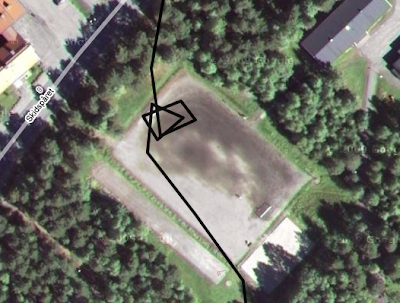

On Tuesday Magnus, Jon and I took the GPS on a drawing excercise to create an interesting line between BildMuseet and HUMlab. After careful study of the edges of the Running Stitch canvas we set of on our bikes in the glorious sunshine. I felt more like the Famous Five than the 'Tour Guide' of the previous day, and we skidded around in football pitches and sports grounds until we realised that some careful planning was required. On arriving at the carpark outside HUMlab we planned an 'H' grid and paced out the shape over several metres. Okay - it's sideways - but you get the idea!
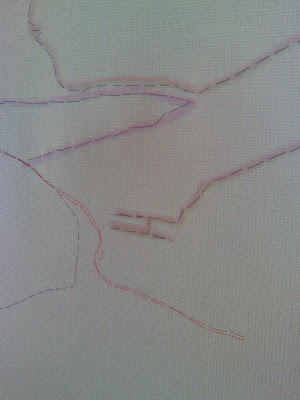
Monday, August 24, 2009
Hacker Attitude

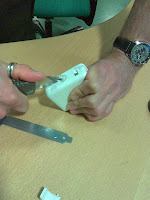
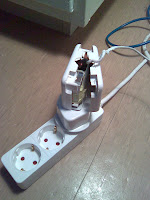
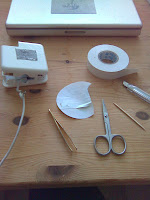 Last night the smoking electricity adapter for my Mac finally sparked it's last dangerous flash of light, never to work again. Leaving me without radio, email, internet, and skype. So I looked on Instructables for a DIY solution to fix the power cable.
Last night the smoking electricity adapter for my Mac finally sparked it's last dangerous flash of light, never to work again. Leaving me without radio, email, internet, and skype. So I looked on Instructables for a DIY solution to fix the power cable. After some bemusement in the lab, I borrowed a sharp knife and Miss Balthazar's Laboratory soldering iron and got to work. Here are the results. Magnus had the perfect solution of using a knife to cut through the plastic seams. Several cuts on each side, and a few round the corners broke the case without the need for hammers and saws.
I stripped the wire beautifully and did a bad soldering job. Then I had to buy some electrical tape and finish the job at home. I used a pair of tweezers to carefully wrap the wires and keep them firmly apart. Nail scissors were also handy for cutting thin strips of tape.
I haven't shut the case yet - I'm just testing - and it works...
Monday, August 17, 2009
Social Fabric
I'm back in Umeå working at HUMlab and the BildMuseet to make all the arrangements for the OSE exhibition to travel to the Musuem of Craft and Folk Art in San Francisco. It's wonderful to situate the project in the tradition of folk culture, blurring distinctions between professional and amatuer, art and craft, participation and collaboration. In the world of folk and folksonomy we can talk about use-value from a different perspective.
Travis Meinolf is an Action Weaver and will be inviting people to make their own weaving during the exhibition. Here you can see his process of constructing a loom:
You might wonder what weaving has to do with Open Source Embroidery... Well, weaving as Travis demonstrates, can be learned and practised by anyone at any level. The process of making a loom can't be copyrighted or owned. There's also the connection between the Jaquard Loom and binary punch-card programming, as discussed earlier in this blog. Interestingly it was these punch cards which were kept under lock and key to prevent copying. On another note, Sadie Plant’s book ‘Zeros and Ones’ 1997, traces a lyrical story of technology and weaving the communications web that we now work within:
“Media has become interactive and hyperactive, the multiplicitous components of an immersive zone which does not begin with writing; it is directly related to the weaving of elaborate figured silks. The yarn is neither metaphorical nor literal, but quite simply material, a gathering of threads which twist and turn through the history of computing, technology, the sciences and the arts.”
Plant, Sadie (1997) p12.
I've just spent a luxurious weekend reading 'Ada, the Enchantress of Numbers: A Selection from the Letters of Lord Byron's Daughter and Her Description of the First Computer', Narrated and Edited by Betty Alexandra Toole. Ada describes the concept of 'poetical science' which is attributed to the influence of her father Lord combined with the mathematical teachings of her mother Lady Lovelace. Toole describes Ada's years looking after her children and teaching as developing "the ability to use and integrate a variety of skills such as digital skills such as objectivity, observation and experimentation, with analogue skills such as imagination, visualisation and the use of metaphor."(Toole, 1992, p93).
It is this integrated approach to learning and technology that the Open Source Embroidery project humbly hopes to explore.
Travis Meinolf is an Action Weaver and will be inviting people to make their own weaving during the exhibition. Here you can see his process of constructing a loom:
You might wonder what weaving has to do with Open Source Embroidery... Well, weaving as Travis demonstrates, can be learned and practised by anyone at any level. The process of making a loom can't be copyrighted or owned. There's also the connection between the Jaquard Loom and binary punch-card programming, as discussed earlier in this blog. Interestingly it was these punch cards which were kept under lock and key to prevent copying. On another note, Sadie Plant’s book ‘Zeros and Ones’ 1997, traces a lyrical story of technology and weaving the communications web that we now work within:
“Media has become interactive and hyperactive, the multiplicitous components of an immersive zone which does not begin with writing; it is directly related to the weaving of elaborate figured silks. The yarn is neither metaphorical nor literal, but quite simply material, a gathering of threads which twist and turn through the history of computing, technology, the sciences and the arts.”
Plant, Sadie (1997) p12.
I've just spent a luxurious weekend reading 'Ada, the Enchantress of Numbers: A Selection from the Letters of Lord Byron's Daughter and Her Description of the First Computer', Narrated and Edited by Betty Alexandra Toole. Ada describes the concept of 'poetical science' which is attributed to the influence of her father Lord combined with the mathematical teachings of her mother Lady Lovelace. Toole describes Ada's years looking after her children and teaching as developing "the ability to use and integrate a variety of skills such as digital skills such as objectivity, observation and experimentation, with analogue skills such as imagination, visualisation and the use of metaphor."(Toole, 1992, p93).
It is this integrated approach to learning and technology that the Open Source Embroidery project humbly hopes to explore.
Friday, June 26, 2009
OSE at Dorkbot London
Several years ago I went along to Dorkfest at the Limehouse Townhall and was nearly blown away by Mike's Electrical stuff. I also picked up a flyer by Isobel entitled 'Dorkette' addressing the 90% male community, and trying to find a point at which more women could engage critically. Her first suggestion was knitting code.... The flyer really inspired me to carry on with Open Source Embroidery, knowing that there must be lots of people interested in the relationship between craft and code. So I was delighted to give a talk about the OSE project and Html Patchwork at the 22 June Dorkbot number 62.
The other speakers were brilliant, and wove a web of ideas and projects which make the virtual material in many different ways: Iain Sharp talked about Lunar Lander his mechanical recreation of the classic arcade game. Mike Harrison demonstrated low voltage neons and high voltage musical instruments. Douglas Repetto, the founder of dorkbot from NYC traced the path of scientific research from sensational press headlines back to the original research papers. His explorations of the various metaphors for brain activity led him to build an amazing synaptic-like sculptural forest complete with birds.
The BBC Tech Website people came to film us and put together a great article about all the different presentations at Dorkbot.
The other speakers were brilliant, and wove a web of ideas and projects which make the virtual material in many different ways: Iain Sharp talked about Lunar Lander his mechanical recreation of the classic arcade game. Mike Harrison demonstrated low voltage neons and high voltage musical instruments. Douglas Repetto, the founder of dorkbot from NYC traced the path of scientific research from sensational press headlines back to the original research papers. His explorations of the various metaphors for brain activity led him to build an amazing synaptic-like sculptural forest complete with birds.
The BBC Tech Website people came to film us and put together a great article about all the different presentations at Dorkbot.
Tuesday, June 16, 2009
Open Source Embroidery Movement
It's exciting to be featured on Wired.com especially as their offices are round the corner from the Museum of Craft and Folk Art in San Francisco, where the exhibition will be shown from October this year.
In the Wired article Priya Ganapati describes Open Source Embroidery as a 'movement' which is an exciting idea. Whilst the exhibition doesn't claim to represent every aspect of art-craft-technology practice, it does capture the zeit-geist of the socio-political aspects of the field.
A 'movement' is forward thinking, distributed, utopian, and often rhetorical. Here it is explored by a network of interlinking communities of makers, programmers, artists and researchers, but has no manifesto or definition as such. I'll muse upon this further and add to this post over the next few weeks. There is something about the representation and inevitable mis-representation of a movement which could be unpicked here.
In the Wired article Priya Ganapati describes Open Source Embroidery as a 'movement' which is an exciting idea. Whilst the exhibition doesn't claim to represent every aspect of art-craft-technology practice, it does capture the zeit-geist of the socio-political aspects of the field.
A 'movement' is forward thinking, distributed, utopian, and often rhetorical. Here it is explored by a network of interlinking communities of makers, programmers, artists and researchers, but has no manifesto or definition as such. I'll muse upon this further and add to this post over the next few weeks. There is something about the representation and inevitable mis-representation of a movement which could be unpicked here.
Monday, June 08, 2009
OSE launch
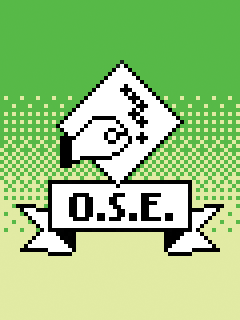
The Open Source Embroidery exhibition opened at BildMuseet this weekend. We had a fantastic Sampling Performance by Yusra Warsama, Jason Singh and David Littler mixing the stories and sounds of music and embroidery sampling. Stephanie Hendrick made a great film of the event (thanks Stephanie). I've also uploaded my PHOTOS of the exhibition and preview. When I went back to the gallery on Sunday there were lots of people listening to the A-Z Audio Stitching and graffiti stitching the chairs. By September they will be completely covered in dense embroidery, which I guess will turn into a tapestry of sorts.
We've all downloaded Kate Pemberton's OSE Pixel Bluetooth onto their mobile. See the giff above. It's being broadcast in the reception area of the exhibition. I'm wondering if someone will embroider the cross stitch pattern onto one of the Sampler Culture Clash chairs?
The exhibition has opened, and will change every week for the next three months as people come and take part in Running Stitch, using GPS to track and stitch their walks around the town. Now I'm off to meet Jen Southern, Jen Hamilton and Chris St Amand, the Running Stitch artists. We're going to Umea University to meet Per Sandstrom who works with the Sami and uses GPS in his research into the movement of reindeer in northern Sweden.
Monday, June 01, 2009
sketchPatch is up!

Hurrah! sketchPatch has launched. Sophie McDonald and Davide Della Casa have worked tirelessly night and day to get this wonderful website up and running. And just in time for the Open Source Embroidery exhibition which opens on Saturday.
sketchPatch is a net-based collaborative programming project developed by artist Sophie McDonald and computer programmer Davide Della Casa. The site enables people to create ‘sketches’ (programmes) with simple processing scripts to create visual, animated and interactive online drawings that can be easily shared and modified, creating a collection of networked artworks. sketchPatch makes Processing code accessible to a broad audience, through a shared learning environment. New coders are encouraged to hack experienced coders work, resampling and modifying the code to create new works. The site allows users to create a new Processing sketch, write and preview the code and save it to a gallery. They can also open an existing Sketch from the gallery and adjust its code, preview and save it as a new piece of work.
Amazing!
Just what we need to get coding (or is that sketching)!
Thursday, May 21, 2009
Open Source Curating
It's about time that I dealt with the question of open source curating, and what this might be. Not only is the methodology of OS seeping into institutional discourse (see the debate at Positions in Flux), I'm increasingly aware of the 'unconventional' methods of curatorial research which I have undertaken for the Open Source Embroidery exhibition. I've also just started teaching on the MFA in Curating at Goldsmiths which is immersing me in diverse curatorial cultures and practices.
There are certain protocols which are ingrained in an unwritten ethics of curatorial practice which I professionally uphold, for example: don't show your own work in an exhibition you are curating; always view work in its real time and space (or the space/media in which it was made) before you show it. Then there are considerations of 'aesthetic standards', 'critical rigour' and 'conceptual integrity'. I use inverted commas here because these criteria are nebulous, hard to define, and often critiqued by art itself. I would probably refer to my process of preference (dare I say selection) as based on the critical relation between form and content, and the ability of the work to problematise the way meaning is constructed in the world. But in general curatorial selection seeks to maintain professional and critical standards. So what happens with open processes? Of course there is no such thing as pure openess - open exhibitions include a large amount of solicited works. Open Calls are sent to certain networks, even Linux was developed on a fairly centralised model. In open methodologies the principles of organisation are defined by the participants in the group. Whilst artist-run spaces have the ability to make such tactical manoeuvres, the institutional requirements of art galleries and museums require more strategic planning, or so they say. My curatorial role flirts with both tactical and strategic modes of operation, and the principles are set through dialogue and discussion with both artists and the exhibition team.
In Open Source Embroidery I break all the rules. I have included my own artwork in the exhibition, selected works recommended on the OSE email list, and am showing some works that I've never seen. Many artworks are by people who have taken part in workshops, and in most museums they would be relegated to the education spaces. But this is the whole point of the project, and rather than compromising the exhibition, the use of 'open source' to transgress the protocols of high culture is a delight. A delight that enables the ethical frameworks of creative practice to become transparent. The politics of the Everyday, the Personal, and of the methods of production and distribution are what is being investigated here. The materials are craft (mostly textiles and some plastic) and code (mostly HTML, some Processing, lots of pixels and some knit patterns). But I fall back to my fine art education and clearly state that I'm no programmer or knitter and I'm not in love with fabric or cables! It's true that I'm not interested in material or technological determinism, or the ambitions of 'fine craft' or even (for this moment in time) the completely horizontal artspace.
Open Source Embroidery is not an 'open' exhibition in the traditional sense. The exhibition has been researched and selected by me. However 'open-ness' did take place at the OSE workshops, and the exhibition will include artworks by people who got involved in the project and made interesting things work. Also curating is not a solitary process, like most jobs it involves working very closely with a team within the constraints of time, space and money. It's also probably accurate to say that the Open Source Embroidery exhibition is an outcome of a research process. It began with B+B back in 2005, when I started to embroider a scarf as a tool to discuss the politics of open source software with artists using open methods in socially engaged practice. My desire to make things to embody the complexity of social and technical language through a folk history of making and collective culture in both craft and coding led me to such an amazing range of artwork I felt that a curatorial response was appropriate.
The challenges of hanging the exhibition start next week. It's all about balancing the critical relationships between works in the exhibition so that people can find their own way through. The works need to have their own space, but also a complex set of juxtapositions without fixing meaning, or worse determining a narrative. Although there are common themes explored through the workshops. A key concern is to present pieces as current, and not static moments in time (always tricky in a museum), to keep the energy and dynamic aspects of process rather than being archival.
Here's Emma Ferguson on her fantastically beautiful stall in Brick Lane market. Emma is showing a selection of embroideries from the 'Expression of Femininity' series, and has made some embroidered tech jewellery for sale during the exhibtion.
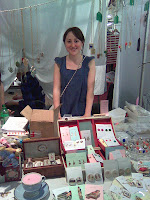
There are certain protocols which are ingrained in an unwritten ethics of curatorial practice which I professionally uphold, for example: don't show your own work in an exhibition you are curating; always view work in its real time and space (or the space/media in which it was made) before you show it. Then there are considerations of 'aesthetic standards', 'critical rigour' and 'conceptual integrity'. I use inverted commas here because these criteria are nebulous, hard to define, and often critiqued by art itself. I would probably refer to my process of preference (dare I say selection) as based on the critical relation between form and content, and the ability of the work to problematise the way meaning is constructed in the world. But in general curatorial selection seeks to maintain professional and critical standards. So what happens with open processes? Of course there is no such thing as pure openess - open exhibitions include a large amount of solicited works. Open Calls are sent to certain networks, even Linux was developed on a fairly centralised model. In open methodologies the principles of organisation are defined by the participants in the group. Whilst artist-run spaces have the ability to make such tactical manoeuvres, the institutional requirements of art galleries and museums require more strategic planning, or so they say. My curatorial role flirts with both tactical and strategic modes of operation, and the principles are set through dialogue and discussion with both artists and the exhibition team.
In Open Source Embroidery I break all the rules. I have included my own artwork in the exhibition, selected works recommended on the OSE email list, and am showing some works that I've never seen. Many artworks are by people who have taken part in workshops, and in most museums they would be relegated to the education spaces. But this is the whole point of the project, and rather than compromising the exhibition, the use of 'open source' to transgress the protocols of high culture is a delight. A delight that enables the ethical frameworks of creative practice to become transparent. The politics of the Everyday, the Personal, and of the methods of production and distribution are what is being investigated here. The materials are craft (mostly textiles and some plastic) and code (mostly HTML, some Processing, lots of pixels and some knit patterns). But I fall back to my fine art education and clearly state that I'm no programmer or knitter and I'm not in love with fabric or cables! It's true that I'm not interested in material or technological determinism, or the ambitions of 'fine craft' or even (for this moment in time) the completely horizontal artspace.
Open Source Embroidery is not an 'open' exhibition in the traditional sense. The exhibition has been researched and selected by me. However 'open-ness' did take place at the OSE workshops, and the exhibition will include artworks by people who got involved in the project and made interesting things work. Also curating is not a solitary process, like most jobs it involves working very closely with a team within the constraints of time, space and money. It's also probably accurate to say that the Open Source Embroidery exhibition is an outcome of a research process. It began with B+B back in 2005, when I started to embroider a scarf as a tool to discuss the politics of open source software with artists using open methods in socially engaged practice. My desire to make things to embody the complexity of social and technical language through a folk history of making and collective culture in both craft and coding led me to such an amazing range of artwork I felt that a curatorial response was appropriate.
The challenges of hanging the exhibition start next week. It's all about balancing the critical relationships between works in the exhibition so that people can find their own way through. The works need to have their own space, but also a complex set of juxtapositions without fixing meaning, or worse determining a narrative. Although there are common themes explored through the workshops. A key concern is to present pieces as current, and not static moments in time (always tricky in a museum), to keep the energy and dynamic aspects of process rather than being archival.
Here's Emma Ferguson on her fantastically beautiful stall in Brick Lane market. Emma is showing a selection of embroideries from the 'Expression of Femininity' series, and has made some embroidered tech jewellery for sale during the exhibtion.

Wednesday, May 13, 2009
Eclectic Tech Carnival comes to Umeå
Eclectic Tech Carnival (/ETC) in Umeå 8-12 June 2009
The Open Source Embroidery exhibition will welcome the Eclectic Tech Carnival during the first week of the exhibition at BildMuseet. On wednesday 10th June the /ETC will be invited to take part in SketchPatch processing, Running Stitch GPS walks, barcode scanning and bluetooth broadcasting. There will also be time to watch the fantastic documentary of Ada Lovelace, and her influence on the history of computing.
/ETC is a week long gathering for women interested in open source technology, art and grass root activism. It encourages women to share experiences and find new opportunities for international collaborations through the use of technology and art. /ETC is an 'on the road-event' held in a new place each year. It was started by the organisation Genderchangers that aims to break stereotypical roles related to technology and encourage and support women to use technology, art and networks as a tool for social change.
/ETC in Umeå is scheduled to take place during the first week of the Open Source Embroidery exhibition at BildMuseet, and will provide an opportunity to engage with the artworks and meet some of the artists.
The Open Source Embroidery exhibition will welcome the Eclectic Tech Carnival during the first week of the exhibition at BildMuseet. On wednesday 10th June the /ETC will be invited to take part in SketchPatch processing, Running Stitch GPS walks, barcode scanning and bluetooth broadcasting. There will also be time to watch the fantastic documentary of Ada Lovelace, and her influence on the history of computing.
/ETC is a week long gathering for women interested in open source technology, art and grass root activism. It encourages women to share experiences and find new opportunities for international collaborations through the use of technology and art. /ETC is an 'on the road-event' held in a new place each year. It was started by the organisation Genderchangers that aims to break stereotypical roles related to technology and encourage and support women to use technology, art and networks as a tool for social change.
/ETC in Umeå is scheduled to take place during the first week of the Open Source Embroidery exhibition at BildMuseet, and will provide an opportunity to engage with the artworks and meet some of the artists.
Sunday, April 26, 2009
Flash Company Worker Stitcher
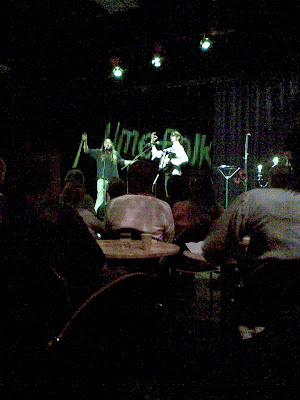
Matt Cowan invited me to embroider a handkerchief for his exhibition at the English Dance and Folk Song Society at Cecil Sharp House in London (opens April 29th). I carried the envelope with the music to the song 'Flash Company' round in my pocket for several months, waiting for an opportune moment to arise.
So when I heard about the Umeå Folk Festival in February - I had to go along with a needle and thread in my bag. On the first day I met up with my friend Phil and lost my ASCII green thread in the bar, so not much sewing took place. But I went back another night and met up with Magnus and Linda, still searching for inspiration for my stitches.
Then the amazing Nano Stern took the stage. On arriving in Sweden Nano was intrigued to hear a children’s song familiar to him from Chile. Nano sang his own version of the song, starting with the original character of the spider, but translating the work of the spider into the idea of a worker, and the spinning of thread into knitting. Weaving together the threads of webs, workers and making, Nano’s passionate song struck a chord with my project. I took out my needle and thread and started stitching in the dark. The picture above shows Folkoholics intense combination of Nano Stern and Matija Solce in the full infectious energy of their song. They certainly blew away the cobwebs from my memories of folk (sitting on a hay bale drinking cider in Cornwall) and brought the whole room into the present with Czech-Chilean humour.
To keep my tradition of html stitching, with a nod to the folk culture of the net, I added www.folkwiki.se embroidered across the bottom of the handkerchief.
Saturday, April 18, 2009
Circles of Participation
This weekend I'm preparing my 'short course' for HUMlab, entitled Net Art and Craft (or Circles of Participation). So rather than spending this glorious sunny afternoon walking by the river and visiting the art school exhibitions I am chewing over the connections between what we might call classic net art, and what might equally be called classic craft. But of course, we have moved beyond the classic modes of craft and net art. The overlaps between these established modes of operation have paved the way for an explosion in super-hip, gender encompassing, flexible circles of participation in which anyone with a rudimentary knowledge of pixels, sewing basket and bandwidth can take part.
These days ask young people what they think of participation on the web and they will tell you of the typical web2 sites, secondlife and the massive online gaming environments. But how many people think of the basic graphics and clunky interfaces of net art as innovative spaces for online creative participation? It's true that without the advertising friendly slickness of gender stereotyped avatars, we may feel a bit lost. But, I'm always more intrigued by the things people build in their sheds. Reliant on my own choices, and a more individual relationship with the intentions of the artist and the possibilities and restrictions of the programme, I am more inclined to try and find out how the art website works, rather than my natural desire to find the edges of the commercial programme, and try and break it.
One of my favourite pieces is Glyphiti by Andy Deck. I first came across this at Furtherfield's HTTP Gallery in London, where I became instantly hooked. Andy Deck has also created Screening Circle, which "adapts the cultural tradition of the quilting circle into online format" as described on the http://artport.whitney.org
Andy's work has the feeling that if you know a bit of programming, and you put your mind to it - you could do this too... if you wanted too. His work is an example of how people can be creative on the net without subscribing to a media giant. But what's really exciting about the web2.0 is its raised the stakes in user-friendlyness, and taught a large section of the population that the web is a space to participate and not just consume. In 2009 artists are creating websites and spaces which have the open principles of the net art generation, with the participatory dexterity of web2.0. The Open Source Embroidery exhibition anticipates this moment, tracing histories and presenting practices which make Net Art and Craft a potent combination for a sustainable culture.
So now to prepare the course!
These days ask young people what they think of participation on the web and they will tell you of the typical web2 sites, secondlife and the massive online gaming environments. But how many people think of the basic graphics and clunky interfaces of net art as innovative spaces for online creative participation? It's true that without the advertising friendly slickness of gender stereotyped avatars, we may feel a bit lost. But, I'm always more intrigued by the things people build in their sheds. Reliant on my own choices, and a more individual relationship with the intentions of the artist and the possibilities and restrictions of the programme, I am more inclined to try and find out how the art website works, rather than my natural desire to find the edges of the commercial programme, and try and break it.
One of my favourite pieces is Glyphiti by Andy Deck. I first came across this at Furtherfield's HTTP Gallery in London, where I became instantly hooked. Andy Deck has also created Screening Circle, which "adapts the cultural tradition of the quilting circle into online format" as described on the http://artport.whitney.org
Andy's work has the feeling that if you know a bit of programming, and you put your mind to it - you could do this too... if you wanted too. His work is an example of how people can be creative on the net without subscribing to a media giant. But what's really exciting about the web2.0 is its raised the stakes in user-friendlyness, and taught a large section of the population that the web is a space to participate and not just consume. In 2009 artists are creating websites and spaces which have the open principles of the net art generation, with the participatory dexterity of web2.0. The Open Source Embroidery exhibition anticipates this moment, tracing histories and presenting practices which make Net Art and Craft a potent combination for a sustainable culture.
So now to prepare the course!
Friday, April 03, 2009
Analytical Women

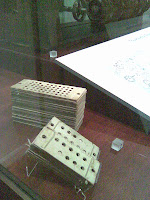 Last Sunday afternoon I went to the Science Museum (appreciating the free entry) with my friend Jake. We went to see the Analytical Engine the Museum built in 1991. I was quite relieved that one of the few sections of the Museum which is not fully computerised all singing all dancing interactivity is the Computer History display! I'm not a programmer, and although the text panel explained that the engine could 'store' information in it's memory, I couldn't quite understand where this is located. However, the punch card system, inspired by the Jaquard Loom, was clear to see.
Last Sunday afternoon I went to the Science Museum (appreciating the free entry) with my friend Jake. We went to see the Analytical Engine the Museum built in 1991. I was quite relieved that one of the few sections of the Museum which is not fully computerised all singing all dancing interactivity is the Computer History display! I'm not a programmer, and although the text panel explained that the engine could 'store' information in it's memory, I couldn't quite understand where this is located. However, the punch card system, inspired by the Jaquard Loom, was clear to see.For a quick intro to Lovelace, Babbage and the Analytical Engine have a peek at Sydney Padua's, fabulous cartoon and here.
The Open Source Embroidery project has led me to some fantastic women working with media arts and crafts in many different ways. Furtherfield invited women to post about women in technology who have inspired them. So I nominated a list of women artists and writers who have inspired me in their analytical rigour, and whose work will, or should, go in the history books. Here they are (in no particular order):
Joanna Drucker / Sneha Solanki / Aileen Derieg / Kate Pemberton / Becky Stern
Wednesday, April 01, 2009
Fångad i någons garn
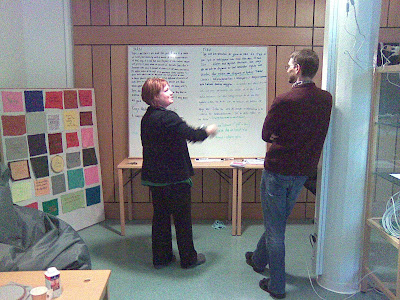
I got back to Umea just in time for the HUMlab Open Day. Charlene and I spent the afternoon inviting people to help translate the Yarn Text into Swedish. It was quite a challenge due to the poetic metaphor of 'yarn' in the Raqs Media Collective's original. But fortunately there are several HUMlab workers who are experts in the language of both craft and code, and were happy to advise. The word 'yarn / garn' didn't translate the idea of a story in Swedish, so we had to be creative. So we used a Swedish saying 'to weave a story', which made more sense than the literal translation of 'to spin a yarn'. But in some cases 'Tråd' made a poetic computing metaphor. For example, the last line is translated as 'That's why Threads (Trådar) make good kernals.' Sadly we didn't manage to squeeze in my favourite saying - tangled up in yarn = 'Fångad i någons garn'.
Charlene also made a great display illustrating the relationship between pixels and cross stitch, and Suzanne showed her Knitted Flat Screen cover.
Tuesday, March 24, 2009
Free Ada Lovelace!
Drop the Charges FREE Ada Lovelace and the South Kensington 3
In 1998 Richard Hamilton designed a series of posters for the Free for All campaign to keep free public entry to the South Kensington Museums. One of the posters depicts Ada Lovelace who worked on the precursor to the modern computer with Charles Babbage, and made analogies between the Jaquard loom and the Analytical engine. Hamilton's use of her image makes connections between issues of freedom and access in both computing and culture, which are central to the concept of the Open Source Embroidery exhibition.
This weekend I plan to visit the Science Museum (one of the South Kensington Museums) to see their Analytical Engine. It is Ada Lovelace's notes on the design for this engine which describe, for the first time, what 'computing' and 'software' might be. And this was in 1843! I'll have to wait until the summer to go to the British Museum to see the original notes.
Today is Ada Lovelace Day in celebration of a woman often mentioned on this blog, such as the Ada Lovelace html embroidery that I stitched, and my notes on the documentary film about her life To Dream Tomorrow. This post contributes to the Ada Lovelace Day Pledge to blog about inspirational women in technology.
As part of the celebration the invigorating Furtherfield.org are inviting all women who work in media arts and net art, who are not already subscribed, to join the NetBehaviour email list for a week between 23rd and 30th March. Women are invited to post about their work and that of other women who have inspired their practice.
In 1998 Richard Hamilton designed a series of posters for the Free for All campaign to keep free public entry to the South Kensington Museums. One of the posters depicts Ada Lovelace who worked on the precursor to the modern computer with Charles Babbage, and made analogies between the Jaquard loom and the Analytical engine. Hamilton's use of her image makes connections between issues of freedom and access in both computing and culture, which are central to the concept of the Open Source Embroidery exhibition.
This weekend I plan to visit the Science Museum (one of the South Kensington Museums) to see their Analytical Engine. It is Ada Lovelace's notes on the design for this engine which describe, for the first time, what 'computing' and 'software' might be. And this was in 1843! I'll have to wait until the summer to go to the British Museum to see the original notes.
Today is Ada Lovelace Day in celebration of a woman often mentioned on this blog, such as the Ada Lovelace html embroidery that I stitched, and my notes on the documentary film about her life To Dream Tomorrow. This post contributes to the Ada Lovelace Day Pledge to blog about inspirational women in technology.
As part of the celebration the invigorating Furtherfield.org are inviting all women who work in media arts and net art, who are not already subscribed, to join the NetBehaviour email list for a week between 23rd and 30th March. Women are invited to post about their work and that of other women who have inspired their practice.
Thursday, January 29, 2009
Translating the YARN Text
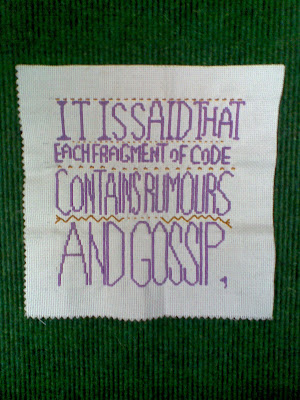 Today was the last HUMlab Syjunta workshop in Sweden, and several people came to finish their patches. They were posted on the design board next to patches from the USA (see Amanda Thackray's patch pictured here) and the UK (thanks to Abi Gibbens and Alex Hodby).
Today was the last HUMlab Syjunta workshop in Sweden, and several people came to finish their patches. They were posted on the design board next to patches from the USA (see Amanda Thackray's patch pictured here) and the UK (thanks to Abi Gibbens and Alex Hodby).Karin has translated the Yarn text into Swedish, which I'll post here as soon as its typed up. We had an interesting discussion about the translation of 'Yarn' which we decided was closer to 'Thread' rather than wool or ribbon. The thread of a story makes sense, even if the 'spinning a yarn' story telling as a big fib doesn't quite translate.
GYRMBC Tent
Thursday, January 22, 2009
New location for the OSE website
The Open Source Embroidery website (including the Html Patchwiki) has been saved by HUMlab - thanks guys.
For some strange reason Fasthosts took it down with no explanation, and it's taken a couple of weeks to get it back and find a new home.
Sorry for the delays,
Ele
For some strange reason Fasthosts took it down with no explanation, and it's taken a couple of weeks to get it back and find a new home.
Sorry for the delays,
Ele
Thursday, January 15, 2009
HUMlab Syjunta January 24-30
24 - 30 January 2009
12.00 – 17.00 daily
Vernissage: Friday 23rd January 4-6pm
Syjunta (GYRMBC): Tuesday 27th January 2-4pm
Syjunta (Yarn): Thursday 29th January 2-4pm
HUMlab Syjunta is an intervention of patterned code and encoded craft into the HUMlab interdisciplinary digital humanities research lab at Umeå University, initiated as part of my research fellowship. The exhibition will present some exisitng OSE artworks (Iain Clark, Paul Grimmer, Clare Roddock, Lisa Wallbank, and James Wallbank) alongside new works in progress created in HUMlab. These will include the collaborative HUMlab GYRMBC Tent, and the collectively stitched Yarn text quilt. Individual works include Suzanne Martin’s Knitted Pattern flat screen cover, Stephanie Wuschitz’s Wireless Women, and Haishu Zhang’s meticulously embroidered HUMlab logo.
HUMlab Syjunta sewing circles will bring together HUMlab html users to stitch the RGB and CMYK hexadecimal colour codes onto the GYRMC tent, and invite the Yarn stitchers to sew their embroidered texts into a single patchwork quilt.
The one-person GYRMBC (Get Your Rabbits Mated Before Christmas) Tent has been created by HUMlab workers to illustrate the combination of RGB and CMYK colour sequences, and to recognise the need for individual creative space alongside the opportunity to collaborate with others.
During November 2008 the Open Source Embroidery Fika workshops at the Fine Art School and HUMlab inspired the stitching of the Raqs Media Collective’s definition of ‘Yarn’ (2003), which describes the metaphorical and material quality of threads, yarn and cables, and how they carry stories through weaving, stitching and bandwidth.
During the HUMlab Syjunta exhibition, I will be embroidering the script for the Patchwiki interface onto the back of the patchwork, so do pop by to say hello.
It's also a great sneak preview of some of the works in progress which will form part of the major Open Source Embroidery exhibition presented at BildMuseet, June 7th – September 6th 2009.
12.00 – 17.00 daily
Vernissage: Friday 23rd January 4-6pm
Syjunta (GYRMBC): Tuesday 27th January 2-4pm
Syjunta (Yarn): Thursday 29th January 2-4pm
HUMlab Syjunta is an intervention of patterned code and encoded craft into the HUMlab interdisciplinary digital humanities research lab at Umeå University, initiated as part of my research fellowship. The exhibition will present some exisitng OSE artworks (Iain Clark, Paul Grimmer, Clare Roddock, Lisa Wallbank, and James Wallbank) alongside new works in progress created in HUMlab. These will include the collaborative HUMlab GYRMBC Tent, and the collectively stitched Yarn text quilt. Individual works include Suzanne Martin’s Knitted Pattern flat screen cover, Stephanie Wuschitz’s Wireless Women, and Haishu Zhang’s meticulously embroidered HUMlab logo.
HUMlab Syjunta sewing circles will bring together HUMlab html users to stitch the RGB and CMYK hexadecimal colour codes onto the GYRMC tent, and invite the Yarn stitchers to sew their embroidered texts into a single patchwork quilt.
The one-person GYRMBC (Get Your Rabbits Mated Before Christmas) Tent has been created by HUMlab workers to illustrate the combination of RGB and CMYK colour sequences, and to recognise the need for individual creative space alongside the opportunity to collaborate with others.
During November 2008 the Open Source Embroidery Fika workshops at the Fine Art School and HUMlab inspired the stitching of the Raqs Media Collective’s definition of ‘Yarn’ (2003), which describes the metaphorical and material quality of threads, yarn and cables, and how they carry stories through weaving, stitching and bandwidth.
During the HUMlab Syjunta exhibition, I will be embroidering the script for the Patchwiki interface onto the back of the patchwork, so do pop by to say hello.
It's also a great sneak preview of some of the works in progress which will form part of the major Open Source Embroidery exhibition presented at BildMuseet, June 7th – September 6th 2009.
Sunday, January 11, 2009
Open Attitude: To be, or not to be, Open Source Embroidery
The concept of Open Source is a problematic one. Not only because of its relationship to free software (GNU/GPL) and the Creative Commons, but as a concept for a development model. Open Source has been so critiqued, that I sometimes wonder if it still has currency as a title for this project. Many of the issues are explored in 'Floss+Art' compiled and edited by Aymeric Mansoux and Marloes de Valk (2008) Published (print on demand) by Goto10 in association with Open Mute.
Rather than getting bogged down in the why's and wherefore's of licensing Olga Gurinova rehabilitates the discourse of freedom and resistance in relation to free and open source software in her essay 'Autocreativity: The Operation of Codes of Freedom in Art and Culture' (p 92-117). She concludes:
"Free Software destabilised existing definitions of property and threatened certain forms of wealth because it touched upon the transformative agents involved in the constitution of relationships, subjectivities and experiences linked into the sphere of production and maintenance of the society. Free Software is not a metaphor in this text used to talk about a different set of problems, but a leap onto the grain problematic of today, the core struggles and weapons. Here what comes on stage is the question how freedom, autonomy, openness operate at different levels?"
(Gorinova (2008) In: Mansoux & de Valk, p116)
The Open Source Embroidery project sits on this stage of questioning - bringing together different approaches and attitudes to valuing creativity. The project aims to reinvestigate and muddle the gaps in the culture of creative production that include: amateur and professional, male and female work, technical and handmade, real and virtual. Rather than situating these as binary positions, they overlap into a myriad of creative activities with an open attitude, finding ways of creating structures to facilitate dialogue and culture.
Perhaps a term like 'Open Attitude' encompasses the 'fit for purpose' approach to tools in the OSE project more comfortably than 'Open Source'. It was Camille Moussette who said he has an 'open attitude' in his work at one of the OSE Fika sessions here at the Fine Art School at Umea University. An 'open attitude' makes total sense in terms of product designers moving away from attempting to patent their next new product, to designing kits for people to build and understand their own technology. The Arduino is a good example here, which is why I'm delighted that Becky Stern will be lending her Lilypad Arduino Embroidery for the OSE exhibition.
And for now the name of the project 'Open Source Embroidery' will remain as it is.
Rather than getting bogged down in the why's and wherefore's of licensing Olga Gurinova rehabilitates the discourse of freedom and resistance in relation to free and open source software in her essay 'Autocreativity: The Operation of Codes of Freedom in Art and Culture' (p 92-117). She concludes:
"Free Software destabilised existing definitions of property and threatened certain forms of wealth because it touched upon the transformative agents involved in the constitution of relationships, subjectivities and experiences linked into the sphere of production and maintenance of the society. Free Software is not a metaphor in this text used to talk about a different set of problems, but a leap onto the grain problematic of today, the core struggles and weapons. Here what comes on stage is the question how freedom, autonomy, openness operate at different levels?"
(Gorinova (2008) In: Mansoux & de Valk, p116)
The Open Source Embroidery project sits on this stage of questioning - bringing together different approaches and attitudes to valuing creativity. The project aims to reinvestigate and muddle the gaps in the culture of creative production that include: amateur and professional, male and female work, technical and handmade, real and virtual. Rather than situating these as binary positions, they overlap into a myriad of creative activities with an open attitude, finding ways of creating structures to facilitate dialogue and culture.
Perhaps a term like 'Open Attitude' encompasses the 'fit for purpose' approach to tools in the OSE project more comfortably than 'Open Source'. It was Camille Moussette who said he has an 'open attitude' in his work at one of the OSE Fika sessions here at the Fine Art School at Umea University. An 'open attitude' makes total sense in terms of product designers moving away from attempting to patent their next new product, to designing kits for people to build and understand their own technology. The Arduino is a good example here, which is why I'm delighted that Becky Stern will be lending her Lilypad Arduino Embroidery for the OSE exhibition.
And for now the name of the project 'Open Source Embroidery' will remain as it is.
Subscribe to:
Posts (Atom)
